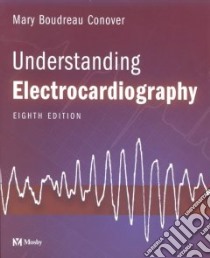Understanding Electrocardiography - 9780323019057
Un libro in lingua di Conover Mary Boudreau edito da Elsevier Science Health Science div, 2002
- € 47.50
- Il prezzo è variabile in funzione del cambio della valuta d’origine
Covering all aspects of electrocardiography, this comprehensive resource helps readers picture the mechanisms of arrhythmias, their ECG patterns, and the options immediately available - as well as those available for a cure. Illustrations and descriptions help the reader visualize and retain knowledge on the mechanisms of cardiac rhythms to pave the way for a systematic approach to ECG recognition and emergency response. This new, eighth edition guarantees the best possible patient outcomes by providing complete coverage - from step-by-step instruction to the more advanced concepts of ECG monitoring. New chapters have been added on The Athlete's ECG, In-Hospital Ischemia Monitoring, and Brugada Syndrome.
- Clear, consistent writing and organization are featured throughout.
- The mechanisms of cardiac rhythms are explained and illustrated for easier comprehension.
- Knowledge builds logically from mechanisms of arrhythmias, axis, and normal rhythms, to arrhythmia recognition.
- Pediatric implications are provided for appropriate arrhythmias.
- Differential diagnoses for arrhythmias are provided to cover all the possibilities of the patient's clinical status.
- A consulting board made up of internationally known experts in ECG recognition assures the content is as accurate and up-to-date as possible.
- Revised and updated chapters include new information regarding mechanisms, risks, diagnosis, therapy, and cures - changing the way patients with arrhythmias and myocardial infarction are managed.
- The chapter on Congenital Long QT syndrome has been thoroughly revised with new information on the recognition of this inherited disease as well as its precipitating circumstances.
- The Acquired Long QT syndrome chapter has been thoroughly revised to describe this life-threatening arrhythmia and list all of the non-cardiac drugs that are now known to cause it.
- The Atrial Flutter chapter has been completely revised to incorporate new diagnostic techniques and improvements in acute and long-term management.
- A new chapter on Brugada Syndrome (Chapter 27) teaches early identification and treatment of those at risk of sudden death from this dangerous ECG pattern.
- A new Athlete's ECG chapter (Chapter 20) describes how intense physical training is associated with ECG patterns that are a consequence of physiologic adaptations of the heart.
- A new chapter on In-Hospital Ischemia Monitoring (Chapter 31) measures the patient's response to therapy and provides an important determinant for survival from myocardial infarction and ischemia.
Informazioni bibliografiche
- Titolo del Libro in lingua: Understanding Electrocardiography
- Lingua: English
- Autore: Conover Mary Boudreau
- Editore: Elsevier Science Health Science div
- Collana: (Paperback)
- Data di Pubblicazione: 22 Gennaio '02
- Genere: MEDICAL
- Argomenti : Electrocardiography Electrocardiography
- Pagine: 507
- Dimensioni mm: 254 x 203 x 19
- ISBN-10: 0323019056
- EAN-13: 9780323019057


